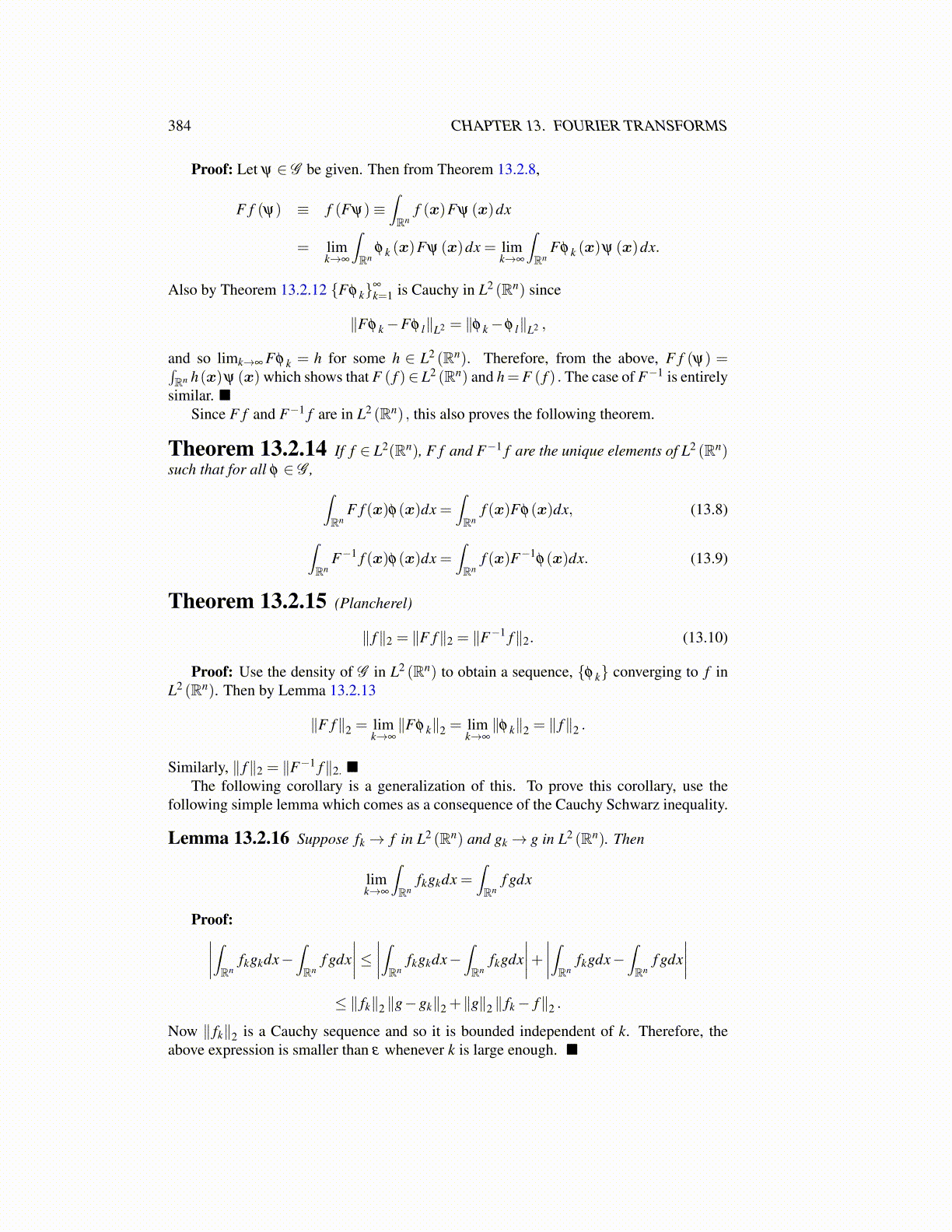
384 CHAPTER 13. FOURIER TRANSFORMS
Proof: Let ψ ∈ G be given. Then from Theorem 13.2.8,
F f (ψ) ≡ f (Fψ)≡∫Rn
f (x)Fψ (x)dx
= limk→∞
∫Rn
φ k (x)Fψ (x)dx = limk→∞
∫Rn
Fφ k (x)ψ (x)dx.
Also by Theorem 13.2.12 {Fφ k}∞
k=1 is Cauchy in L2 (Rn) since
∥Fφ k−Fφ l∥L2 = ∥φ k−φ l∥L2 ,
and so limk→∞ Fφ k = h for some h ∈ L2 (Rn). Therefore, from the above, F f (ψ) =∫Rn h(x)ψ (x) which shows that F ( f )∈ L2 (Rn) and h=F ( f ) . The case of F−1 is entirely
similar. ■Since F f and F−1 f are in L2 (Rn) , this also proves the following theorem.
Theorem 13.2.14 If f ∈ L2(Rn), F f and F−1 f are the unique elements of L2 (Rn)such that for all φ ∈ G , ∫
RnF f (x)φ(x)dx =
∫Rn
f (x)Fφ(x)dx, (13.8)
∫Rn
F−1 f (x)φ(x)dx =∫Rn
f (x)F−1φ(x)dx. (13.9)
Theorem 13.2.15 (Plancherel)
∥ f∥2 = ∥F f∥2 = ∥F−1 f∥2. (13.10)
Proof: Use the density of G in L2 (Rn) to obtain a sequence, {φ k} converging to f inL2 (Rn). Then by Lemma 13.2.13
∥F f∥2 = limk→∞
∥Fφ k∥2 = limk→∞
∥φ k∥2 = ∥ f∥2 .
Similarly, ∥ f∥2 = ∥F−1 f∥2. ■The following corollary is a generalization of this. To prove this corollary, use the
following simple lemma which comes as a consequence of the Cauchy Schwarz inequality.
Lemma 13.2.16 Suppose fk→ f in L2 (Rn) and gk→ g in L2 (Rn). Then
limk→∞
∫Rn
fkgkdx =∫Rn
f gdx
Proof:∣∣∣∣∫Rnfkgkdx−
∫Rn
f gdx∣∣∣∣≤ ∣∣∣∣∫Rn
fkgkdx−∫Rn
fkgdx∣∣∣∣+ ∣∣∣∣∫Rn
fkgdx−∫Rn
f gdx∣∣∣∣
≤ ∥ fk∥2 ∥g−gk∥2 +∥g∥2 ∥ fk− f∥2 .
Now ∥ fk∥2 is a Cauchy sequence and so it is bounded independent of k. Therefore, theabove expression is smaller than ε whenever k is large enough. ■